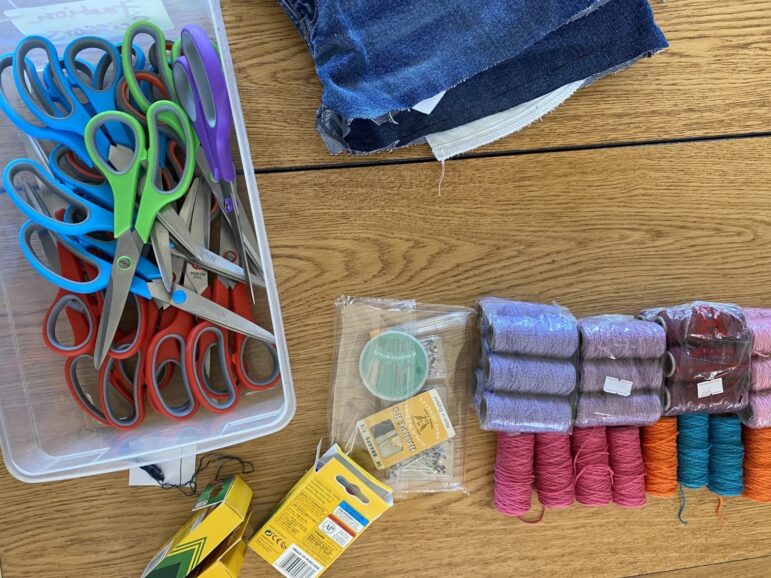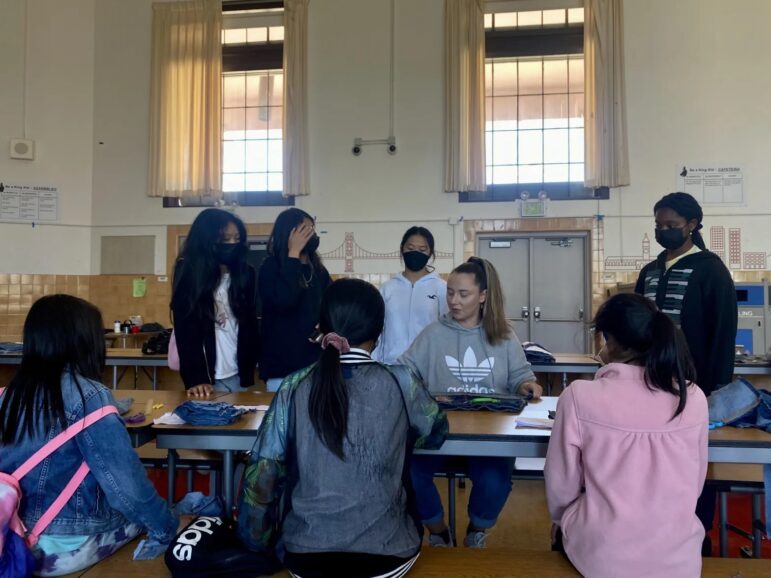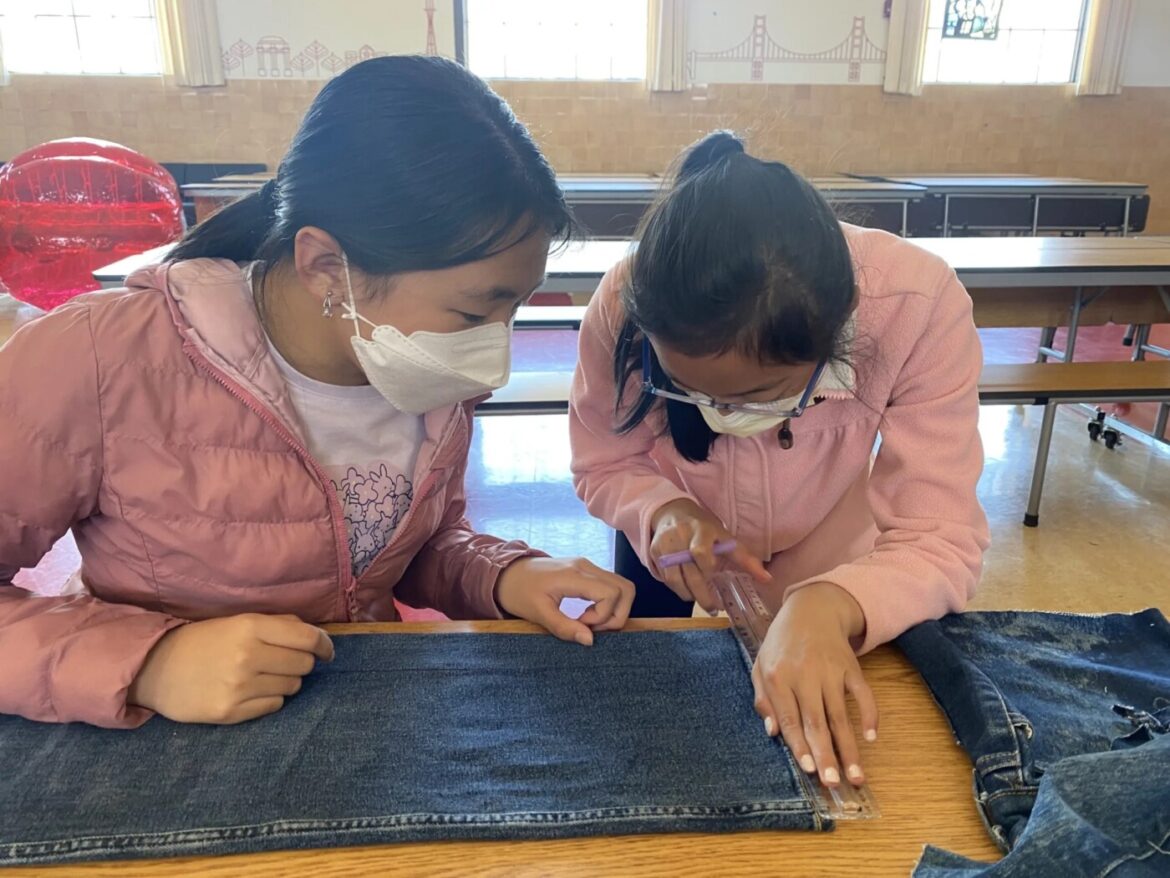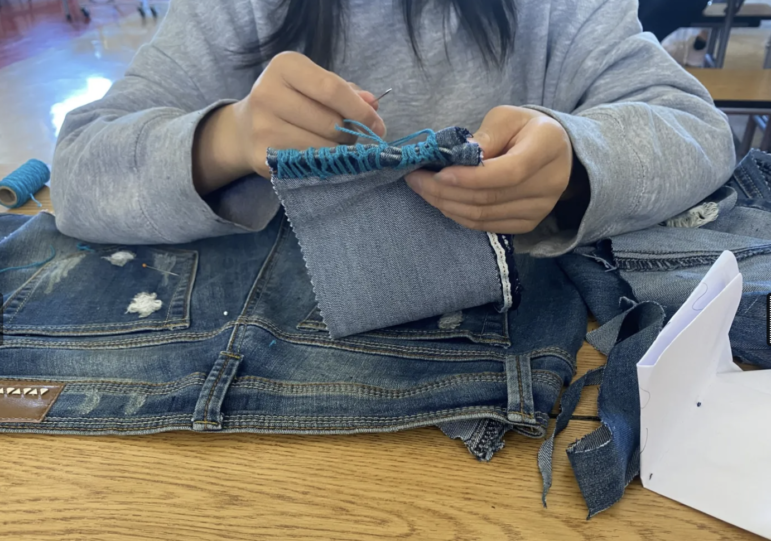On a weekday afternoon in July, dozens of donated pairs of Levi’s jeans lay scattered across cafeteria tables, waiting to be repurposed into tote bags. The young designers, students at a summer program held at Dr. Martin Luther King Jr. Academic Middle School in San Francisco, pile in and begin searching for the denim garments labeled with their names.
The students are participating in a sustainable fashion design class hosted by the San Francisco-based nonprofit SCRAP. Their teacher, designer Elena Slivnyak, calls everyone around her as she demonstrates how to stitch two ends of fabric together.
“If you make your stitches far apart, you’re going to have holes,” she advises during her demo. “You don’t want to make the string too long, or it’s going to get tangled!”
Still a nascent program, SCRAP began its Sustainable Fashion Design Program this spring to teach youth ages 12-18 about sustainable practices they can bring to their own closets. Through upcycling projects, the kids learn techniques such as hand-sewing, embroidery, creative purposing and garment construction.
This fall, SCRAP plans on expanding the program by increasing school partnerships and creating curriculum that educates students about the fashion industry through an environmental lens.
With colorful sticks of chalk and spools of embroidery thread, the young students in Slivnyak’s July class mark, measure, trim and sew their own creations as they construct their tote bags. A wandering Slivnyak makes her way to each table to help students with their sewing if they get stuck.

While students display varied attention spans, Slivnyak says she’s still learning to adjust her time with a younger classroom to get them interested in sustainable clothing.
Though a “Project Runway” alumna, whose designs have been praised by clients such as Lady Gaga and Tyra Banks, Slivnyak acknowledges her new, young audience might be the hardest to impress yet.
“They’re tough!”, she exclaims. “I’m still testing the waters to see what works and what doesn’t. Just from these few classes, I’m already starting to put the puzzle together.”
The SCRAP nonprofit has long brought its philosophy of creative reuse to classrooms; its “SCRAP in a Box” Program brings one-hour art classes and delivers art supplies to students in San Francisco’s underserved communities. Educational programming is just one feature of SCRAP’s work that diverts 220 tons of materials from entering the waste stream annually.
SCRAP was founded in 1976, as an arts education program with no budget that began to source materials from landfills and industrial waste. Today, SCRAP exists as the nation’s oldest creative reuse center and continues its mission of inspiring environmental stewardship and creativity through art by providing the community with reusable, discarded materials.
As the fashion industry steadily climbs the ranks of the world’s top polluters, SCRAP’s dedication to sustainability and the innovation of creative reuse is needed more than ever.
Excessive water consumption needed for cotton production, toxic wastewater from textile factories, plastic-microfiber pollution from synthetic garments and the increasing emissions of clothing transportation are all aspects of the fashion industry contributing to climate change.
As a designer and brand owner herself, Slivnyak is particularly critical of commitments to sustainable practices by clothing corporations. “A lot of companies are doing it, but I don’t think they’re doing it fast enough,” she says.
In the greater push for a sustainable fashion movement, tensions lie between the responsibilities of clothing corporations and of the individual consumer.
Fast fashion propels consumption cycles by setting micro-trends consumers feel compelled to follow, rapidly increasing the tons of textile waste that end up in landfills every year. Yet it remains the most affordable option for garment shopping — an issue that SCRAP has identified within the communities its programs serve.
SCRAP’s program coordinator Danielle Grant acknowledges the seemingly paradoxical connection between sustainability and affordability.
“We don’t believe these aspects are at odds,” she says. “We are hoping to teach kids about fast fashion, where those clothes come from and the working conditions that make them so inexpensive, but also that there are more affordable alternatives to fast fashion.”

While the broader issue of textile waste weighs heavily on the fashion industry and manufacturers themselves, SCRAP is showing members of the younger generation that change can be made in their very own closet — a lesson with growing relevance as the changing climate ensues.
“If you can keep something in your closet for long periods of time, and it doesn’t go away and into the garbage can, that’s already sustainable in its own way,” Slivnyak comments.
By educating students about the relationship between fashion and the environment, as well as introducing them to design skills, SCRAP’s programs foster both sustainability and creativity among future generations.
“Having embellishment, mending and construction skills, you can keep clothes in your rotation for longer and see more possibilities when you shop,” Grant says.
To donate to, volunteer with, or learn more about SCRAP Creative Reuse, visit https://scrapcreativereuse.org/.


